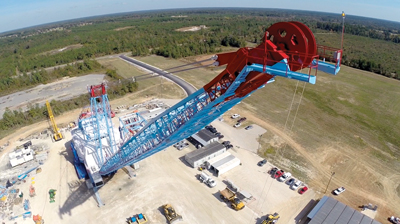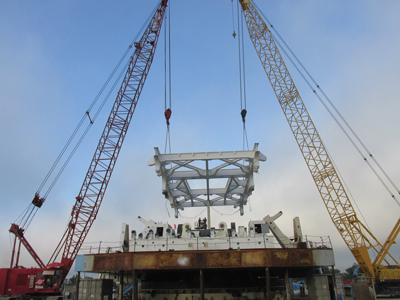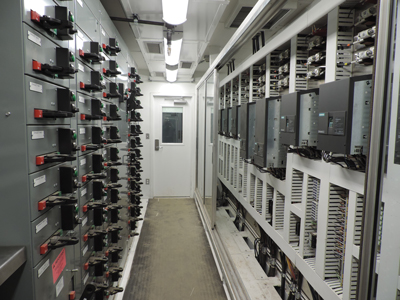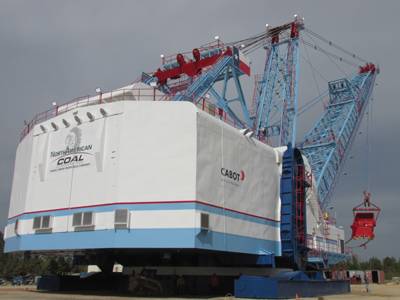NORTH AMERICAN COAL RELOCATES AND REFURBISHES A DRAGLINE
By Donna Schmidt, Field Editor
| A recently restored Page 757 dragline sits on the assembly area at NA Coal’s Cabot Marshall mine in Texas. After making the move from Wyoming and being fully restored with many upgrades, the new dragline, Carmen, began production in January. |
It is not every day that a dragline changes hands and moves from one place to another. It is even less common for that dragline to travel nearly 1,300 miles to its new home, be totally refurbished and upgraded, and put into service below budget, well within time schedule and with no major safety issues.
Cabot Corp. and North American Coal Co. (NA Coal), in partnership with the mining division of industrial construction and fabrication firm CCC Group, has done just that with a 7.5-million-lb Page 757 dragline. After hundreds of thousands of man-hours, the freshly overhauled unit, Carmen, was dedicated in November 2014 as Cabot Corp.’s first dragline.
The massive machine was originally constructed in 1978 and spent its first 27 years at the Bridger Coal complex in Rock Springs, Wyoming. Cabot, which purchased the dragline and worked with NA Coal and CCC to begin the dismantling process in the last quarter of 2012, made quick work of what would become a two-year upgrade process conducted simultaneously with preparation work for its new Marshall mine in Harrison County, Texas, due west of Shreveport.
THE PLAN
The Cabot Marshall mine, operated by NA Coal’s subsidiary business unit Caddo Creek Resources, was developed as a new supplier for the Cabot Activated Carbon Plant in Marshall, Texas. With an expected mine life of about 50 years, it is certain to fit that bill. The site for the new mining project was within a reserve that had not previously been mined; land acquisition, planning and permitting for the operation work began in 2009 and mining permits were approved in 2012 and 2013.
 |
| This is not a simulator; it’s a nighttime photo taken from inside a completely upgraded operator’s cabin. |
With the U.S. in the midst of landmark regulatory changes related to mercury emissions from coal-fired power plants, known as the Mercury and Air Toxics Standard (MATS), set to go into place this April, it promises to alter the way coal is used for power generation for the foreseeable future. Additionally, the regulations are expected to significantly boost demand for activated carbon, as many coal-fired utility companies will utilize it to capture mercury and reduce these emissions by up to 90%. The lignite from the Marshall mine is the primary raw material for Cabot’s nearby activated carbon plant, and while the product is used extensively for a variety of air purification applications, from industrial processes to landfills, it is also widely used in water purification and food and beverage purification.
MAKING THE MOVE FROM WYOMING TO TEXAS
Before the dragline could take its first pass, the entire machine needed to be transported from the western coalfields of Wyoming to eastern Texas and be completely restored. The Page 757 is no lightweight — powered by two 3,500-hp synchronous motors, the unit features a 57-ft diameter roller circle and a 320-ft boom with a 290-ft operating radius at a 38˚ angle; the bucket has a 62-cubic-yard capacity and the unit as a whole checks in at a little less than 7.5 million lb.
Walking the machine to its new Texas home was not a viable option. So, Cabot and NA Coal teamed with San Antonio-based CCC Group to begin a 554-day dismantling and rebuild project. It took 180 truckloads, the heaviest weighing in at 157,000 lb, to transport the dragline, and a total of more than 200,000 man-hours to dismantle and totally rebuild it. CCC successfully accommodated a five-month pause in the rebuild phase while Cabot re-analyzed the project economics, all the while working together to control costs on the job.
CCC officials said it leaned on its strategic alliance partner, Joy Global Dragline Services, to provide the dragline engineering, spare parts, and technical capability it needed for the Marshall project as part of its mission to deliver complete life cycle management for Cabot and NA Coal.
 |
| The dragline features a 57-ft diameter roller circle and a 320-ft boom with a 290-ft operating radius at a 38° angle. |
The Caddo Creek Resources team, meanwhile, drew from its past experiences of rebuilding numerous other draglines over two decades as it began making decisions related to the rebuild and the technology it would incorporate into the dragline for its next chapter of service.
“We evaluated the available used machines across North America at the time, and this machine fitted the Marshall mine application,” said Vice President of Global Manufacturing, Cabot Norit Activated Carbon, Rob Davies . “NA Coal has experience in Page, Bucyrus and Marion draglines, and this Page machine will be able to mine the whole coal reserve.”
He also noted that the mine plan always had assumed that a dragline, particularly a pre-owned and rebuilt unit, would be at the heart of its operations. “An economic analysis showed this to be the lowest cost option over the life of the mine,” he said.
“We also found our primary goals and the safety culture of our teams were closely aligned. Both Cabot and NA Coal treat safety as their first priority and it was refreshing to see such a strong cultural fit between the two partners.”
Cabot officials noted they had not previously worked with CCC. They, however, found that the collaboration was mutually beneficial from the start.
“In any rebuild project, cost is a key consideration, and the combined teams were very thorough in the equipment inspection process and Caddo Creek Resources, based on their past history in maintaining draglines, developed a very thorough and efficient budget that fully addressed the restoration needs of the dragline,” Davies said.
Cold weather played a part in the disassembly in Wyoming, but CCC was careful in their planning such that only two days were lost due to weather. In east Texas, rain and wind were the biggest weather factors, but CCC worked well to accommodate these situations as well.
Based on the equipment history and changes made to the dragline by former owner Bridger Coal, Cabot Project Manager Travis Mileur and Caddo Creek Resources Project Manager Spencer Thompson elected to do a number of upgrades that would aid in the productivity and efficiency of Carmen at Marshall. These included a new truss, which incorporated an improved design to minimize cracking at the high stress points, as well as an onboard transformer.
“In this application it was less costly and more reliable to install an onboard transformer with 25 kv cable feeding from the substation to the dragline,” Mileur said.
 |
| A two-crane lift setting the modified superstructure on the machine. |
Donald Jean of CCC subcontractor Drives and Controls Services (DCS), retained to assist with the electrical upgrades on dragline projects, said the onboard transformer upgrade was necessitated by the change in the power system of the dragline from 8 kv to 25 kv; 25 kv is preferred due to increased line efficiency on the grid.
“The revolving frame deck was expanded with ‘transformer extensions’ on the left and right sides of the machine behind the propel girders,” he said. “This allowed for the additional square footage needed to accommodate the transformers.”
He also noted that the ballast of the machine was recalculated to account for the difference in weight after the upgrades were complete. DCS accomplished all the electrical engineering needed to connect the transformers.
Other changes included the rebuild of all gear cases that selectively replaced gears, along with all of the bearings and seals, with the work completed by Joy Global. Thicker base plates were installed on the unit beneath the hoist and drag drums at the recommendation of Joy Global, which noted some buckling in the floor. A hoist drum lock was also added to improve bearing life. Ultrasonic testing was conducted on the boom, along with a thorough review of past boom issues. Because of its I-beam design, the team determined that cracking was not a significant issue.
 |
| The inside of Carmen’s new modern control room with updated digital drives. |
Interestingly, Cabot opted not to do an AC upgrade, instead choosing to rebuild all of the DC electric motors and generators. “Variable AC was evaluated, but with the anticipated production schedule and the general recondition cost, it was financially better to rebuild existing DC equipment,” Mileur said.
CCC noted that several modifications were also made to Carmen to assist with ease and efficiency of use along with operator health and safety. These included an entirely new upper superstructure, an enhanced operator cab with state-of-the-art operator chair and larger viewing windows, a modern anteroom, and all-new electrical upgrades such as LED lighting, a complete PLC operating system and new elevated floor plates for the unit’s cabling. New hoist and drag pads were added to the dragline’s infrastructure, as was an extended rear section of the revolving frame.
WALKING OFF THE PAD
Post-rebuild, both Cabot and NA Coal have nothing but positive feedback on their collaboration and the support of CCC. While neither will discuss specific dollar figures, one celebratory factor of the enormous project was the ability for both to bring it to a close both under budget and well within anticipated timeframes. Both companies attributed that to the resources and technical expertise brought to the project by CCC. Cabot and NA Coal are happy to talk about another significant positive: more than 200,000 man-hours from start to finish with no major safety issues, recordable incidents or lost-time injuries.
“The project was accomplished with only four minor incidents,” Mine Manager Gene Beener said. “This achievement was accomplished by conducting daily safety meetings every morning along with a constant presence of Caddo Creek Resources safety personnel initiating site and equipment inspections throughout the day.”
“Cabot has a strong safety culture, and we worked well with Caddo Creek Resources and CCC to make sure the job site was safe and still got the productivity on the rebuild. CCC provided weekly updates on progress besides our own analysis, and we met weekly to make sure we stayed on task, addressed problems and reviewed costs.”
 |
| The revolving frame deck was expanded with transformer extensions on the left and right sides of the machine behind the propel girders, making the machine broader across the back. |
CCC officials also noted that its safety achievement would not have been possible without a close client-contractor relationship focused on safety, from an organized and clean work site to a combined crew that took ownership in the pair’s safety standards — particularly with regards to the rigorous federal MSHA requirements in place for such a project.
Carmen began moving overburden in November 2014 and the mine went into full production on January 1. Since production started, there has been no looking back for the team at the Marshall mine; officials report all is going well at the lignite reserve, where 33 employees currently work. Eventually, Caddo Creek Resources said 42 will be on the payroll at the operation. All workers, both production and maintenance, work on two split crews covering an 80-hour-per-week schedule consisting of 10-hour shifts (eight shifts on and six shifts off) with two shifts each Thursday.
“Caddo Creek Resources will use standard North American Coal maintenance practices that are used at the other NAC mines,” Davies said of the plan to keep its dragline going strong for the long haul. “Caddo Creek Resources will also have a core group of employees from other NA Coal mines to ensure consistent operating and maintenance procedures.”
The lignite reserve, a single seam that averages 3.6 ft thick and 60 ft deep, will be uncovered at Marshall with a simple dig-and-side-cast method, then drilled and sampled for the implementation of a loading plan that meets the Cabot plant’s quality requirements. The lignite will then be loaded with a Wirtgen 2200 surface miner directly into Cabot’s 25-ton OTR trucks, which will transport the lignite 23 miles to the activated carbon plant.
Carmen’s spoil will be graded to approximate original contour and covered with 4 ft of suitable plant growth material, Cabot officials noted.
In remarks at the opening ceremony, Cabot Corp. CEO Patrick Prevost called the newest mine is its portfolio “a significant milestone” for the company.
“We see this as not only a great opportunity for Cabot, but also an opportunity for regional development,” noting that lignite coal has been an ingredient in the high-quality activated carbon production chain since 1921.
“The new mine and dragline extends our leadership position in the mercury emission control segment, [and] as a leading supplier of activated carbon, Cabot is well positioned to be a strategic partner to coal-fired power plant owners and operators in mercury emission control.
Cabot is the only activated carbon manufacturer with multiple manufacturing sites dedicated to this application in North America, and NA Coal is the largest lignite producer in the United States with multiple surface operations totaling more than 35 million tons annually in combined production.
ABOUT NORTH AMERICAN COAL
North American Coal Co., a division of NACCO Industries, mines and markets lignite, bituminous and metallurgical coal in North Dakota, Mississippi, Alabama, Texas and Louisiana. The company, one of the nation’s top coal producers, owns eight surface operations and currently has an additional two in development. Its total lignite coal reserves is 2.2 billion tons, 1.1 billion tons of which is committed.
NA Coal also provides dragline mining services operating under the name North American Mining Co. for independently owned limerock quarries in Florida.
The company was initially founded in 1913 as the Cleveland and Western Coal Co. Four years later, it purchased three coal operations and became both a miner and coal seller. It changed its name to the North American Coal Corp. in 1925.
NACCO transitioned from an underground to surface mining operator in the 1980s, focusing at that time on lignite coal. Today, in addition to Caddo Creek, its mines include the Five Forks operation in Louisiana, Liberty and Red Hills in Mississippi, Falkirk and Freedom in North Dakota and the Eagle Pass and Sabine mines in Texas.
ABOUT CABOT CORP.
Boston-based global specialty chemicals and performance materials company Cabot Corp. serves the transportation, infrastructure, environment and consumer industries. For more than 130 years, it has provided products such as rubber and specialty carbons, cesium formate brines, activated carbon, aerogel, fine cesium chemicals, fumed metal oxides, graphenes, inkjet colorants, masterbatches and conductive compounds.
With a staff of 4,600 worldwide, Cabot is committed to sustainable business practices that ensure the well-being of its employees, customers and the communities in which it operates. Cabot Norit Activated Carbon offers a variety of activated carbon products for air, water and other fluid purification and solutions for flue gas treatment and mercury control applications.
ABOUT CCC GROUP
Moving and construction service firm CCC Group previously completed more than 70 dragline rebuilds or new builds prior to the NACCO project, as well as more than 1,000 other mining-related projects in 30 U.S. states for some of the nation’s largest operators.
CCC offers clients in-house fabrication, machining and hydraulic repairs services, specialty engineering related to dust control and material transfer technologies.
The company, which has core competencies in civil, concrete, structural, equipment setting, piping, electrical, instrumentation and fabrication, started as a family-owned business in 1947 and is now an employee-owned firm with 10 regional offices and two international offices.

